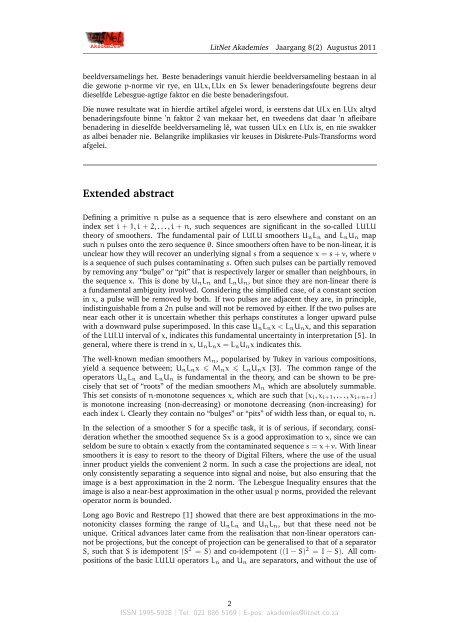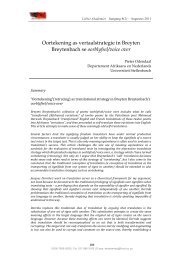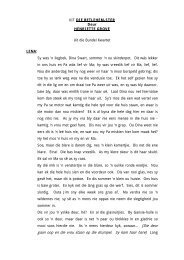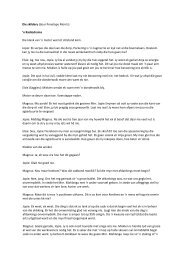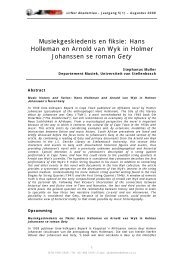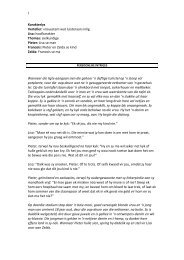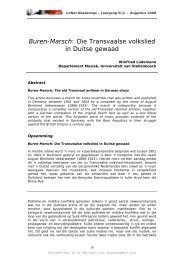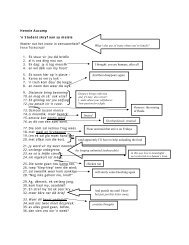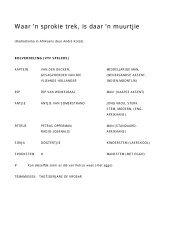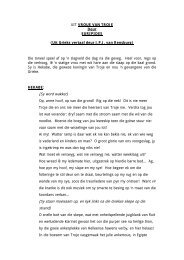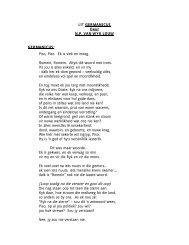Jaargang 8, nommer 2 – Augustus 2011 - LitNet
Jaargang 8, nommer 2 – Augustus 2011 - LitNet
Jaargang 8, nommer 2 – Augustus 2011 - LitNet
Create successful ePaper yourself
Turn your PDF publications into a flip-book with our unique Google optimized e-Paper software.
<strong>LitNet</strong> Akademies <strong>Jaargang</strong> 8(2) <strong>Augustus</strong> <strong>2011</strong><br />
beeldversamelings het. Beste benaderings vanuit hierdie beeldversameling bestaan in al<br />
die gewone p-norme vir rye, en ULx, LUx en Sx lewer benaderingsfoute begrens deur<br />
dieselfde Lebesgue-agtige faktor en die beste benaderingsfout.<br />
Die nuwe resultate wat in hierdie artikel afgelei word, is eerstens dat ULx en LUx altyd<br />
benaderingsfoute binne ’n faktor 2 van mekaar het, en tweedens dat daar ’n afleibare<br />
benadering in dieselfde beeldversameling lê, wat tussen ULx en LUx is, en nie swakker<br />
as albei benader nie. Belangrike implikasies vir keuses in Diskrete-Puls-Transforms word<br />
afgelei.<br />
Extended abstract<br />
Defining a primitive n pulse as a sequence that is zero elsewhere and constant on an<br />
index set i + 1, i + 2, . . . , i + n, such sequences are significant in the so-called LULU<br />
theory of smoothers. The fundamental pair of LULU smoothers UnLn and LnUn map<br />
such n pulses onto the zero sequence θ. Since smoothers often have to be non-linear, it is<br />
unclear how they will recover an underlying signal s from a sequence x = s + v, where v<br />
is a sequence of such pulses contaminating s. Often such pulses can be partially removed<br />
by removing any “bulge” or “pit” that is respectively larger or smaller than neighbours, in<br />
the sequence x. This is done by UnLn and LnUn, but since they are non-linear there is<br />
a fundamental ambiguity involved. Considering the simplified case, of a constant section<br />
in x, a pulse will be removed by both. If two pulses are adjacent they are, in principle,<br />
indistinguishable from a 2n pulse and will not be removed by either. If the two pulses are<br />
near each other it is uncertain whether this perhaps constitutes a longer upward pulse<br />
with a downward pulse superimposed. In this case UnLnx < LnUnx, and this separation<br />
of the LULU interval of x, indicates this fundamental uncertainty in interpretation [5]. In<br />
general, where there is trend in x, UnLnx = LnUnx indicates this.<br />
The well-known median smoothers Mn, popularised by Tukey in various compositions,<br />
yield a sequence between; UnLnx Mnx LnUnx [3]. The common range of the<br />
operators UnLn and LnUn is fundamental in the theory, and can be shown to be precisely<br />
that set of “roots” of the median smoothers Mn which are absolutely summable.<br />
This set consists of n-monotone sequences x, which are such that {xi, xi+1, . . . , xi+n+1}<br />
is monotone increasing (non-decreasing) or monotone decreasing (non-increasing) for<br />
each index i. Clearly they contain no “bulges” or “pits” of width less than, or equal to, n.<br />
In the selection of a smoother S for a specific task, it is of serious, if secondary, consideration<br />
whether the smoothed sequence Sx is a good approximation to x, since we can<br />
seldom be sure to obtain x exactly from the contaminated sequence s = x + v. With linear<br />
smoothers it is easy to resort to the theory of Digital Filters, where the use of the usual<br />
inner product yields the convenient 2 norm. In such a case the projections are ideal, not<br />
only consistently separating a sequence into signal and noise, but also ensuring that the<br />
image is a best approximation in the 2 norm. The Lebesgue Inequality ensures that the<br />
image is also a near-best approximation in the other usual p norms, provided the relevant<br />
operator norm is bounded.<br />
Long ago Bovic and Restrepo [1] showed that there are best approximations in the monotonicity<br />
classes forming the range of UnLn and UnLn, but that these need not be<br />
unique. Critical advances later came from the realisation that non-linear operators cannot<br />
be projections, but the concept of projection can be generalised to that of a separator<br />
S, such that S is idempotent (S 2 = S) and co-idempotent ((I − S) 2 = I − S). All compositions<br />
of the basic LULU operators Ln and Un are separators, and without the use of<br />
2<br />
ISSN 1995-5928 | Tel: 021 886 5169 | E-pos: akademies@litnet.co.za


